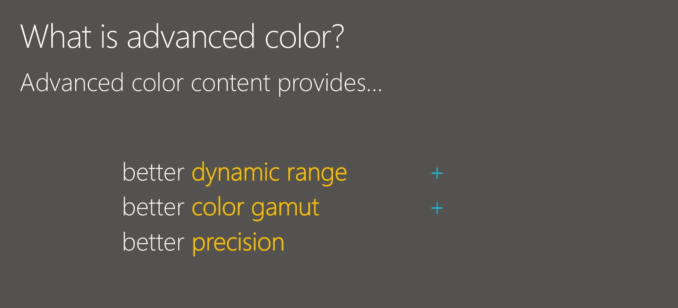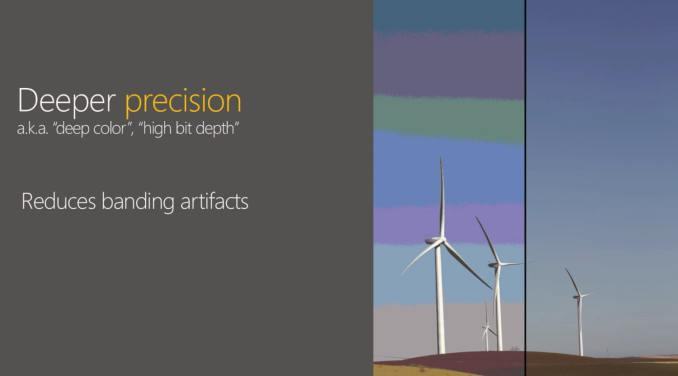The Microsoft Build 2017 Recap: What To Expect When You’re Expecting Windows
by Brett Howse on May 19, 2017 8:00 AM ESTHDR and Wide Color Gamut Support
Windows has never had a color management system to speak of, although individual developers could create their own. That did happen, but it was generally reserved for applications for media creation from companies like Adobe. With the increase in wide color gamut (WCG) devices, we’ve had some concern that this is going to continue to be an issue going forward.
Luckily this is a problem that Microsoft has been aware of for some time, and wider color gamuts, along with the introduction of high dynamic range (HDR) on televisions and displays are pressuring them to come up with a solution sooner than later. Luckily, they have made some progress here, and we were able to discuss this with Kam VedBrat, Partner Group Program Manager, and Simon Tao, Program Manager II from Microsoft to get their take on where they are at now, and where they are going.
Simon Tao has a presentation on Channel 9, and if you’re interested in this, check out his video here.
First off, we discussed where Microsoft is at now with HDR and WCG support, and their first step into this realm was actually with the Xbox One S, which launched in mid-2016. With the more constrained environment, they were able to add in new display capabilities with a known hardware pipeline. This allowed them to work closely with their content providers as well to enable HDR support in their apps. When you think about it, this makes a lot of sense, and it’s a great advantage to now have the Xbox running Windows 10 so they can use it for specific use cases like this.
Kam and Simon also discussed how the new Windows development cycle is a much better process for them, because adding HDR and WCG support into Windows is a huge undertaking. In the old method of Windows updates every couple of years, they would have been forced to add most or all of their code in one round, and if you had missed your timeline, that could mean a long wait until Windows was updated again. With the new servicing model though, they can be much more staggered in their approach, adding code that is ready now, and then learning from that code running on real machines to guide changes and adjustments for the next wave.
Creators Update actually shipped the first steps towards a high color aware OS, although it is limited to certain hardware configurations at the moment. That shouldn’t be a huge issue though, since there aren’t a lot of HDR monitors on the market yet.
With the Creators Update, Windows now has the ability to remap sRGB content into FP16 half-floats, which can then be tone-mapped from FP16 to lower precision for the final output depending on the displays capabilities. This also includes luminance which is important with HDR displays that can high much higher levels of brightness. HDR is not to make everything brighter, but to improve highlights and created a wider range of brightness levels from absolute black to the highest brightness.
For now, this is mainly being targeted towards game developers so they can use the hardware to its maximum potential, and have their product fulfill their artistic goals. But with the Creators Update, other capabilities are already available, including the media pipeline.
Right now, the onus is on the developer to bring these ideas to market, and to worry about the correct tone mapping based on the display attached to the PC, but the long term goal is to make this available to more developers, or hopefully to even have Windows handle much of this on its own. Having this available in a limited form right now though lets the team get valuable feedback from not just users, but developers as well, to see where they need to make changes. There’s still a long way to go for this to be fully implemented, but with Windows being updated twice per year now, there will be lots of chances to see this evolve and come to life.













85 Comments
View All Comments
Meteor2 - Saturday, May 20, 2017 - link
One way of thinking about it could be the amount of value created per platform (as GDP type value). While there's probably more mobile client devices around than desktops/laptops, I bet the large majority of value comes from the latter, and always will.mkozakewich - Tuesday, May 23, 2017 - link
While I was impressed by the Stream 7 and other $100 Windows devices, I do wish we had some higher-priced options. I'd love a 7" tablet with OLED, Gorilla Glass, and 4 GB of RAM.BrokenCrayons - Friday, May 19, 2017 - link
I know Linux is still basically a rounding error worth of installed systems, but since Windows 8 was released, the number numbers have show very slow, but steady increases. The fact that it's consistently above 2% now is pretty cool, but for those of us using it, I wouldn't bother celebrating yet. It's got a long way to go before it becomes a significant factor.peevee - Friday, May 19, 2017 - link
"The fact that it's consistently above 2% now is pretty cool"Probably the result of Chinese and Russian governments not wanting to use Windows or MacOS and switching to their domestically cooked distros of Linux.
Meteor2 - Saturday, May 20, 2017 - link
Is that a thing? After all, the Russian government was hit by WannaCry.versesuvius - Saturday, May 20, 2017 - link
People grow up gaming on Windows and along the way pick up some other software which they learn and become dependent on and when they are engineers, doctors, lawyers or housewives or jobless or whatever keep on playing games and software. There is nothing that Linux does not do better than Windows except gaming. That is the whole idea of Windows and as long as Windows is a good platform for gaming the same story repeats itself ad infinitum. Unless of course Linux starts paying more attention to gaming and there is a Linux version of popular games on the market. Another thing that that plays a part in the popularity of Windows albeit not as much as the above is what the late Dennis Ritchie described as its "feeling of Snappiness". The apps do not load any faster on Windows than on Linux and Linux even loads them faster most of the time but the Windows feels snappy, so people feel that are doing something more or their time is not being wasted whereas in reality the time that Windows wastes for its users is almost equal or even more than the time that people spend time actually doing something on Windows.sadsteve - Saturday, May 20, 2017 - link
I now dual boot Windows 10 and Mint Linux. Linux definitely boots up faster for me. It's to the point where the only time I boot Windows is to play a game that's not available on Linux. l could even use Linux for work, if my company would let me, since all the tools I use are available for both OSes.anactoraaron - Friday, May 19, 2017 - link
So with this next major update will they finally stop this insane automatic download and install of garbage apps? Just had to refresh a pc that would no longer join my domain and watched in horror as windows automatically downloaded and installed 10+ apps. Eclipse manager, pandora, adobe express, on and on the apps kept coming. Why oh why do they do this?neogodless - Friday, May 19, 2017 - link
What brand computer? Was this configured by the manufacturer to do this? I've never seen this on a clean install of Windows 10. (Just one... to four... data point(s), though!)Macpoedel - Saturday, May 20, 2017 - link
I have seen this on a clean Windows install, last weekend I installed Windows 10 Pro v1703 (Creator's update) on a NUC, latest iso at that time, and it tried to install all kinds of apps from the Play Store. I don't think Intel could configure this if I brought my own iso, download from Microsoft's website. Maybe hardware manufacturers also have the capability to mark apps as "updates" even when you're using your own install media (kind of like drivers?), but I think this was Microsoft's doing.At first I thought this was some leftover from using the same account on a branded laptop earlier, those apps got tied to my account library and Windows 10 tries to install all of the apps in the library when you set things up. But on the other hand, I haven't setup a branded machine running the factory image since Windows 7... And also, the UWP apps that I actively have installed on other machines, didn't get installed automatically.
So unless my girlfriend is installing those apps behind my back, Microsoft is pushing those apps on us.